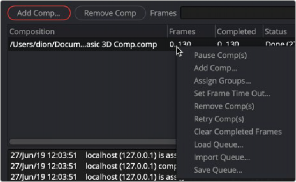< Previous | Contents | Next >
Automatic Rejoining of the Queue
If a Render node becomes unavailable to the Render Master for any reason, frames assigned to that Render node are reassigned among the remaining Render nodes in the list.
When the Render node becomes available for rendering again, it will signal the Render Master that it is ready to render again, and new frames will be assigned to that Render node.
This is why it is important to set the Render Master in the network preferences of the Render nodes. If the master is not set, the Render node will not know what master to contact when it becomes available.
In the Fusion Render node Preferences, select the Tweaks panel. Using the Last Render node Restart Timeout field, you can enter the number of seconds Fusion waits after the last Render node goes offline before aborting that queue and waiting for direct intervention.
Relaunching Render Nodes with Fusion Server
Fusion Server is a small utility installed with Fusion Studio and the Render node. The application is Fusion Server is a small utility installed with Fusion Studio and the Render node. The application is silently launched by each Fusion Render node when started.
Fusion Server monitors the Render node to ensure that the Render node is still running during a render. It consumes almost no CPU cycles and very little RAM. If the monitored Render node
disappears from the system’s process list without issuing a proper shutdown signal, as can happen after a crash, the Fusion Server relaunches the Render node, allowing it to rejoin the render.
Fusion Server will only detect situations where the Render node has exited abnormally. If the Render node is still in the process list but has become unresponsive for some reason, the Fusion Server cannot detect the problem. Hung processes like this are detected and handled by frame timeouts, as described below.
![]()
Frame Timeouts
Frame timeouts are a fail-safe method of canceling a Render node’s render if a frame takes longer than the specified time (with a default of 60 minutes, or one hour). The frame timeout ensures that an overnight render will continue if a composition hangs or begins swapping excessively and fails to complete its assigned frame.
The timeout is set per composition in the queue. To change the timeout value for a composition from the default of 60 minutes, right-click on the composition in the Render Manager’s queue list and select Set Frame Timeout from the contextual menu.

Right-click over a comp in the Render Manager to set a timeout value.